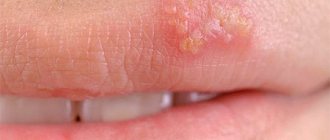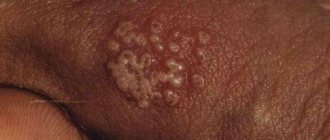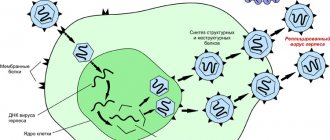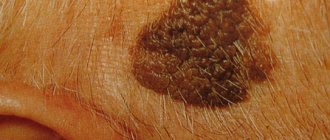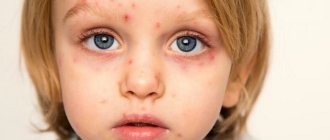One of the main features of the herpes virus is its ability to infect any area of the skin and mucous membranes. Herpes on the neck is one of the rather severe clinical manifestations of this virus.
90% of people are carriers of various types of herpes virus, and it is usually present in the body in a latent, hidden form
, becoming more active during any weakening of the immune system.
The skin of the neck is highly sensitive, so rashes on the neck are especially unpleasant. And constant touching of hands or clothing to this part of the body can provoke a secondary infection.
Causes leading to the appearance of a rash
If a rash on the neck appears as a result of infection with the herpes virus, then the following options may be considered as the cause:
- Types 1 and 2 of the virus : most often manifest as a “cold” on the lips, but if self-infected they can spread to the neck area;
- Varicella-zoster virus (type 3) : causes both chickenpox and shingles. Most cases of herpes on the neck are manifestations of shingles;
- Epstein-Barr virus (type 4) and cytomegalovirus : skin rash is not a characteristic symptom of infection with these viruses and occurs only in patients with a very weakened immune system.
The main factors that “trigger” the virus include any conditions that undermine the immune system: hypothermia, colds (flu, ARVI), stress, the presence of concomitant infections, taking antibiotics
etc.
Causes
Herpes on the neck occurs when the virus is transmitted through contact and household contact.
After infection, it settles in nerve cells and becomes inactive.
Signs of the disease appear under the influence of the following factors:
- reduced immunity;
- colds and infectious diseases;
- constant stress;
- excessive physical activity;
- immunosuppressive therapy;
- surgical interventions;
- hypothermia of the body;
- vitamin deficiency;
- pregnancy.
Other possible causes of the rash
In addition to the herpes virus, skin rashes on the neck can be caused by:
- Fluctuations in hormonal levels;
- Poor personal hygiene;
- Allergic reaction to clothing made of synthetic fabric, perfumes, household chemicals;
- Gastrointestinal diseases;
- Other viral infections (measles, rubella).
One of the main features of herpes zoster, which distinguishes it from urticaria (an allergic reaction), is the unilateral primary localization of the rash - on the left or right side of the neck.
Another distinctive feature of this type of herpes is the ability to affect the nervous system and cause neuralgic pain. The pain can radiate to nearby parts of the body - head, arm, chest.
Symptoms of herpes on the neck
Rashes on the neck go through 4 stages of development:
- It all starts with skin itching, redness and tingling; when scratching, the skin becomes inflamed;
- A reddish rash appears on the affected area, consisting of small, painful blisters filled with clear liquid; over time, they increase in size, and the liquid contained in them becomes cloudy; itching and burning intensify;
- The bubbles burst, the liquid flows out; at this stage the person is contagious to others;
- The ulcers remaining in place of the vesicles dry out and become covered with a crust, which cannot be picked off to avoid relapse.
Scratching a herpetic rash on the neck is strictly prohibited - this can lead to the addition of a secondary fungal or bacterial infection, as well as to the formation of scars after the rash disappears.
In the general statistics of all cases of herpes zoster, rashes on the neck account for 12%.
Additionally, herpes zoster on the neck is accompanied by signs of general intoxication, which include:
- General weakness;
- Increased body temperature, fever, chills;
- Headaches and dizziness;
- Nausea;
- Appetite and sleep disorders;
- Enlarged lymph nodes.
Why does herpes occur?
In the modern world, there are more than two hundred different viruses that cause herpes. Approximately 95% of the world's population carries this disease.
Herpes on the neck is caused by certain pathogenic types of viruses. It most often affects the mucous membrane of the lips or the mucous membrane of the genitals, but can also be transferred from one part of the body to another.
Any touching the areas affected by the rash can cause the disease to be transferred to healthy areas. The cause of lesions on the neck or head is herpes zoster. It causes a lot of trouble, severe itching and weeping wounds.
Like any type of virus, rashes on the neck have several stages. The first sign is redness of the skin and unpleasant itching. Then bubbles with liquid appear, the itching intensifies, and the temperature may rise.
Treatment of herpes on the neck
At the first symptoms, such as a rash on the neck, itching, redness, you can lubricate the problem area with Acyclovir and take a Paracetamol tablet. For correct diagnosis and clarification of the diagnosis, it is better to consult a doctor: a virological study is carried out using the PCR method or the fluorescence method.
Effective treatment of the herpes virus should be comprehensive and include:
- The use of antiviral drugs (in the form of external use (ointments) and tablets);
- General restoratives and immunomodulatory drugs: interferon, nonspecific immunostimulants;
- Painkillers;
- Antipyretics (in case of high temperature).
One of the following antiviral drugs is prescribed:
- Valtrex – 2 tablets 3 times a day for a week;
- Famvir (has an anti-inflammatory effect) – 1 tablet 3 times a day for a week;
- Valaciclovir – 2 tablets 3 times a day for a week.
Antiviral drugs are used both to relieve the clinical symptoms of the disease and to prevent possible relapses in patients with reduced immunity.
It is impossible to completely get rid of the herpes virus, but you can extinguish its activity.
The following are used for external use:
- Zovirax – applied to the rash 4-5 times a day for 5-10 days;
- Acyclovir - applied 5 times a day for 5-10 days;
- Devirs - applied with massaging movements 5 times a day for 5-8 days;
- Panavir - applied 5 times a day for 4-10 days.
As a local treatment (ointments), antiviral agents are effective only at the stage of vesicular rashes. Once erosions have formed, their effectiveness is significantly reduced.
Manifestations of neuralgia are significantly reduced by painkillers such as Lidocaine and Acetaminophen
.
In order to strengthen the immune system, it is recommended to pay more attention to your diet, making sure that it is balanced and complete. When fighting the herpes virus, vitamins A, B and E are especially important, as well as ascorbic acid in combination with rutin . In addition to eating foods rich in these vitamins, it is recommended to take multivitamin complexes 2 times a year.
Vitamin A increases local immunity, the protective function of the skin and mucous membranes and prevents the virus from penetrating into the body;
Vitamin C increases the activity of white blood cells and the production of interferon, protecting body tissues from free radicals, and also helps preserve vitamin E, which is a powerful antioxidant;
Also, microelements such as zinc and selenium . Zinc protects cell membranes from the oxidative effects of other elements (iron and copper). An ointment containing zinc accelerates the healing of ulcers and reduces the intensity of blistering.
A healthy lifestyle and any measures aimed at strengthening the body's natural defenses are of great importance in the treatment of herpes. It is recommended to spend more time in the fresh air and carefully monitor personal hygiene.
There are also traditional medicine recipes for the treatment of herpes on the neck: you can treat rashes on the neck with camphor or fir oil, earwax 2-3 times a day.
You can make water compresses with interferon, which are applied to the areas affected by the rash. Additionally, natural herbal preparations are taken to improve immunity: echinacea extract, ginseng, cordyceps
.
The following also have good antivirus properties:
- Propolis extract is a natural bee product that is included in various ointments and is available in tablets;
- Garlic extract;
- Breast milk.
Forms and varieties
Depending on the strain of the viral disease, the rash on the human body can be localized around the corners of the mouth, on the lips or wings of the nose, and can blister the genitals or the skin of the back and abdomen. At the first symptoms of activation of the pathology, it is necessary to consult a doctor, who, after conducting a visual examination and receiving the results of laboratory tests, will make a diagnosis and prescribe treatment.
Absolutely all types of human herpes viruses belong to the Alphaherpesvirinae family. Of these, the three most common are:
- HSV-1;
- HSV-2;
- chicken pox.
Each of these strains is characterized by an acute outbreak and rapid course of the disease, as well as a characteristic rash of the mucous membranes or skin.
The next subfamily of human herpes viruses is Gammaherpesvirinae. It includes four main types of the disease:
- type 4 (Epstein-Barr virus);
- 6 type;
- 7 type;
- 8 type
These types of herpes pose a slightly greater danger to humans than the previous ones. They do not manifest themselves visually, but when the infection becomes active, the virus rapidly attacks internal organs and changes the composition of the blood.
And the last strain of herpes is Bethaherpesvirinae. This is a rather insidious type of virus.
Like all others, cytomegalovirus infection can lie dormant in the body for years, but when activated, it quickly affects internal organs such as the kidneys, lungs, and liver.
Very often, pathology is the root cause of a disease such as mononucleosis, damage to the central nervous system.
Infectious agents
When a characteristic rash appears on the neck, the cause may be infection with viruses that cause herpes simplex and shingles:
- Herpes simplex virus (HSV types 1 and 2). The manifestation of the first pathogen most often causes a “cold on the lips”, the second – genital herpes. Types 1 and 2 pathogens are the main causes of herpes on the neck.
- Varicella-Zoster virus. Penetrating into the body for the first time, it causes chickenpox (usually in childhood). A secondary manifestation of its activity is herpes zoster. The pathogen spreads along the affected nerves, causing a specific skin reaction.
Herpetic rash: photo No. 1 - for herpes simplex virus, photo No. 2 - for herpes zoster
Activation of these pathogens is the cause of herpes on the neck. Each virus manifests itself differently, so it is important to know the main symptoms of the disease.
Reasons for the development of herpes
The main reasons for the penetration of the herpes virus into the body in the neck, at the initial stage, is the presence of small cuts, cracks or abrasions on the skin or mucous membrane, which gives rise to the development of the disease. Therefore, it is important not to forget that herpes is a contagious viral disease that is transmitted from person to person. The virus can exist in a latent state or, in the worst case, infect tissues in the spine, where the virus usually multiplies without noticeable symptoms, and often lies dormant, waiting for certain body conditions to arise that promote its activation.
The main factors contributing to the infection of a healthy body are its close contact with an infected person and the presence of pathogenic herpes viruses in a healthy body. Often the virus appears in a child after kindergarten, as he has to communicate with other children who may be infected. The causes of herpes on the neck will be diagnosed by medical specialists when you seek their help, which helps to facilitate treatment.
Symptoms
Different types of viruses are characterized by certain manifestations of the disease. They differ for pathogens of types 1-2 and 3.
For herpes simplex virus
The first manifestations of herpes on the neck are not immediately noticed. First, redness of small areas of the skin appears, as well as itching and tingling of the neck. If a person immediately understands that he is developing the herpes simplex virus, it is easier to get rid of the disease - just use Zovirax ointment.
The following stages of disease development are characterized by the following symptoms:
- A day after the first symptoms appear, the patient notices the appearance of bubbles in the reddened area. They contain a clear liquid.
- Over time, the bubbles increase in size and the liquid becomes cloudier.
- The bubbles burst. At the same time, liquid flows out of them, which contains many herpes pathogens. During this period, the patient is considered the most dangerous carrier of the virus.
- The bubbles become crusty. This stage characterizes a person’s recovery. The disease must be treated even after crusts have formed. During this same period, a person ceases to be infectious.
It is important to know all the features of a herpetic infection in order to visit a doctor on time. The first of these is itching in the neck area. Bubbles with liquid appear after 1–2 weeks.
A common symptom of activation of the herpes simplex virus in the neck is enlarged lymph nodes. However, it does not always appear.
Herpes simplex virus on the neck
For shingles
Herpes virus infection begins to develop in adults who have had chickenpox. The disease goes through several stages:
- There is a severe headache, impaired digestion, general malaise, and chills. In patients with different immune systems, the severity of manifestations differs. Symptoms may persist for 72 hours or more.
- In the area of future rashes on the neck, a person feels burning and itching. The temperature rises, appetite is impaired.
- The area of the epidermis on the neck swells, spots 4–5 mm in diameter appear on it. Within 24 hours, they transform into vesicles containing serous contents.
- After a few days, the swelling decreases, and the contents of the bubbles become cloudy. Features of the rash include its simultaneous drying. Crusts form. The patient notes an improvement in general health. Body temperature returns to normal.
With the standard course of shingles on the neck, the patient recovers in 3 weeks. After the rash disappears, hyperpigmented areas of the skin remain on the neck.
Herpes zoster on the neck
How to treat herpes on the neck
Treatment of herpetic infection on the neck is carried out taking into account the type of pathogen, the state of immunity and the age of the patient.
For herpes simplex
When herpes simplex appears on the neck, the following is used for treatment at home:
The doctor may prescribe Panavir gel to the patient. External products have many advantages:
- ease of use;
- high efficiency;
- safety;
- portability.
Anti-inflammatory drugs based on Ibuprofen and Diclofenac are used as additional agents. The patient is prescribed a multivitamin complex, as well as painkillers.
Panavir and Acyclovir
The dosage of medications for children must be selected by the doctor, taking into account the age and body weight, as well as the state of the child’s immunity. Foci of localized rashes are usually smeared with brilliant green.
For herpes zoster
In the case of herpes on the neck caused by Varicella-Zoster virus particles, complex treatment is carried out. To relieve exacerbations, adults are shown:
- Preparations based on acyclovir. Adult patients are prescribed 800 mg of medication 3 times a day. It is recommended to drink plenty of fluids during treatment.
- Products based on valacyclovir. They must be taken for a week, 3 times a day, 1 thousand mg.
- Drugs based on famciclovir (“Famvir”). They are given to patients at 1500 mg, dividing this dosage into 3 doses over the course of a week.
Antiviral agents applied to the affected area of the neck help to quickly cure herpes on the neck. This herpes medicine can be more effective by using it immediately after itching and tingling appear. Treatment for shingles may include physical therapy.
Treatment of herpes zoster
Treatment
Unfortunately, there is no such treatment or medicine yet that could completely destroy HSV in the human body once and for all. Usually herpes goes away on its own within a week, leaving no trace behind. Treatment can be done at home and consists of providing relief from pain and discomfort due to the ulcers. The main factor is to prevent the spread of infection.
The patient is usually prescribed painkillers such as Paracetamol or Ibuprofen to relieve pain. Treatment for herpes on the neck is quick, provided it is applied at the first sign of tingling or burning. In some cases, if the infection is particularly severe or there are frequent relapses, the doctor may prescribe antiviral drugs, for example, Valtrex.
The patient should try not to touch the sores and wash their hands to prevent the infection from spreading not only to other people, but even to other parts of their body, such as the eyes.
Possible complications
The virus often affects the facial and trigeminal nerves. Ganglionitis of the Gasserian ganglion. This complication is one of the most severe. The patient experiences excruciating pain in the face and entire head.
The pain is more pronounced in the area where the nerve endings exit the cranial foramina:
- upper jaws;
- corners of the mouth;
- brow ridges.
As the disease progresses, you may notice drooping at one corner of the mouth, an inability to open an eye, or a flattening of the forehead on one side.
Postherpetic neuralgia is one of the common complications of postherpetic infection in the neck. In this disease, several peripheral nerve ganglia that extend from the spinal cord become inflamed. There are no motor disorders. In the area where herpes occurs on the neck, a person feels severe pain. It has a paroxysmal, shooting character.
Ophthalmoherpes is one of the rare consequences of herpes zoster. The pathological process affects the eyeball and its appendages. The eyelids become red and swollen. The cornea becomes cloudy, vision is weakened. Without treatment for herpes, complete or partial loss of vision is possible.
Causes
Herpes is a chronic infection that occurs with periods of reactivation and remission. Herpes on the neck can appear for 2 reasons:
- reactivation or initial encounter with herpes simplex viruses type 1 and 2;
- reactivation of the herpes zoster virus (type 3) is a manifestation of herpes zoster.
Most often, herpes on the neck is the result of reactivation of HSV type 3 and is called herpes zoster . Cervical localization of herpes zoster is not considered widespread, since the virus is located in the nerves of the torso and head.
The cause of this disease is considered to be previous chickenpox, the recurrence of which occurs in the form of herpes zoster.
Herpes viruses primarily infect nervous tissues and exhibit their pathogenic effects on the skin. This applies to both the herpes simplex virus and the chickenpox or shingles virus.
The reason for the reactivation of herpesvirus infection is a decrease in the body’s defenses, namely the cellular component of immunity.
Against the background of hypothermia, physical injury, stress, chronic diseases, taking immunosuppressive drugs (hormones, cytostatics), both types of infection can worsen and manifest as herpetic rashes on various parts of the body.
Herpes zoster often accompanies the period after organ transplantation.
A rash on the neck, the cause of which is insufficient activity of the immune system, is described by an abundance of elements and a severe course. The same applies to oncological diseases, severe anemia, long-term use of glucocorticoids, and anticancer drugs.
Herpes on the neck, the causes of which include injury, pregnancy, hypothermia, usually occurs in a mild or moderate form.
Herpes virus types 1 and 2 are most often localized on the mucous membranes of the lips, the skin of the lips, face, and occasionally rashes appear on the neck. A rash on the neck with herpes zoster appears much more often than with simple herpes.
The incidence of herpes zoster is more often recorded in the older age group. This is due to the fact that children suffer from chickenpox, and a certain time interval is required for the infection to recur.
Therefore, children who have had chickenpox in utero with herpes zoster or chickenpox in a pregnant woman may suffer a relapse in childhood. Also at risk for developing shingles are children who had chickenpox before the age of 18 months.
Frequent recurrences of a herpetic rash on the neck in an adult, the causes of which are not the presence of diagnosed tumors, taking medications, or hypothermia, require testing for HIV.
Repeated relapses of herpes zoster, as a rule, occur very rarely - no more than 5% of cases.
Herpes simplex virus type 1. How the disease spreads
This type of disease affects the skin and mucous membranes of the upper body: face, lips, nose, inner surface of the cheeks, gums, conjunctiva and cornea of the eyes, fingers. People usually become infected by the age of three, and children under 6 months have immunity received from their mother.
The following types of herpes are distinguished:
- Primary.
- First (not primary).
- Recurrent.
Primary herpes develops in individuals who have not previously encountered infection. Symptoms of herpes often do not appear, however, in children with problematic immunity or malnourished children, the disease can manifest itself in severe form with severe hyperthermia and significant enlargement of the lymph nodes, but skin symptoms are often absent.
The first infection is contact with the pathogen in individuals who are immune to HSV-1 with HSV-2 type and vice versa. They are often easier to tolerate and do not cause a systemic reaction.
The recurrent form of the disease is associated with the “awakening” of a virus living in sensitive autonomic nerve endings, nodes and nuclei of cranial nerves, olfactory bulb and lacrimal gland. This occurs under the influence of factors that weaken the body’s defenses:
- excessive sun exposure;
- hypothermia;
- influenza or ARVI;
- bacterial infections;
- stress and emotional overstrain;
- menstruation;
- surgical interventions;
- taking drugs that suppress the immune system (for example, corticosteroids);
- exacerbation of chronic diseases.
Stages of development
Primary infection with type 3 herpes viruses occurs through airborne droplets. The infection is considered highly contagious, meaning there is a high chance of infection since the virus is volatile. After chickenpox, the virus lies dormant in the dorsal roots of the spinal cord.
Depending on the specific location of the viral particles, recurrences of chickenpox in the form of herpes zoster can occur in different anatomical areas and most often affect the chest, abdomen, back and lower back.
If the zoster virus affects the dorsal roots of the cervical part of the spinal cord, the rash will be localized on the neck.
Infection with herpes simplex occurs through contact and household contact. The virus penetrates microcracks and wounds, which leads to the appearance of a characteristic rash. Next, the herpes virus enters a latent stage and the number of relapses is determined by the state of the immune system.
Herpes simplex affects the skin of the neck in two ways:
- in the presence of injuries to the skin of the neck and contact penetration of the virus into the wounds, a rash develops on the neck;
- with an exacerbation of herpes simplex on the face and a marked decrease in the tension of immune forces, the rash can spread to the neck.
Stages of development of a rash on the neck during infection with HSV types 1 and 2:
- Penetration of the virus into the epithelial cells of the skin of the neck.
- Active reproduction in cells with their destruction, tissue inflammation and the formation of a rash. This stage is accompanied by typical symptoms: burning, itching, redness, papule, vesicle.
- New viral particles enter the blood.
- Herpes settles in the nerve ganglia.
- When immunity decreases, viral particles multiply and penetrate the skin along the axons of nerve cells and cause a relapse.
The stages of development of herpes zoster on the neck have the same pathogenesis links. But unlike HSV types 1 and 2, primary infection with herpes zoster leads to the development of classic chickenpox.
After recovery, the particles penetrate the dorsal roots of the spinal cord and, with a decrease in immune strength, cause a relapse in the form of herpes zoster on the skin.
Types of herpes on the body
Skin herpes (photo 1.1) occurs in various types. Most often, patients are accustomed to seeing herpes simplex - it affects the lips and face. But there are other types of herpes on the body, which are much less common, but bring patients no less concern.
The classification of the herpes virus includes many types of herpes, but for humans the most interesting are herpes viruses types 1-8, which cause various serious diseases.
Types of herpes on the body (photo 2) are as follows:
- Herpes simplex infection is divided into serotypes 1 and 2. It is the first serotype of a simple virus that we most often observe the stages of herpes on the lips, when they are covered with painful blisters. In the literature, this type is called labial herpes (see photo 3), also oral or labial. This is the most common type of pathogen; a person usually receives it in the first years of life. 95% of the world's population are carriers of the herpes simplex virus. Usually the virus affects the area of the nasolabial triangle, but when immunity decreases, it can be found on the fingers and on the nasal mucosa. The herpes simplex virus can cause intestinal herpes and even infect the tissues of the nervous system, remaining there in a latent state. It is due to this ability to adapt and inhibit phagocytosis that the herpes virus is so common among people;
- herpes type 2 (photo 4) is called genital, or anogenital, due to the fact that it can also affect the anus area. Typically, herpes virus type 2 is transmitted sexually. Most often, patients who have reached puberty become ill with it, and the risks of infection increase in direct proportion to the number of sexual partners. Herpes of the second type affects mainly women, and antibodies to the virus of the first type do not work at all against the virus of the second type. Due to its ability to be practically asymptomatic, the virus has received the common name atypical herpes - this indicates that characteristic signs of the disease cannot be expected. The atypical nature of herpes is abortive, allergic, erosive-ulcerative herpes, and a hemorrhagic-necrotic and edematous form of the disease is observed. The disease herpes with the second type virus is characterized by relapses, and in many cases the disease threatens with malignancy - the appearance of genital cancer in women and men. The detection of herpes cells in the blood is a potential threat to health; in connection with this threat, doctors recommend that carriers of herpesvirus type 2 be regularly tested for tumor markers;
- Herpes virus type 3 is chickenpox, or chickenpox, which is familiar to many. It is also called Zoster. The virus is transmitted by airborne droplets or by contact with a sick person. After chickenpox, the carrier remains for life; the virus hides in the nervous system. If immunity is reduced, herpes zoster appears in humans - this is the same third type of virus, only in the acute stage. Chickenpox has a generally typical course - a herpes rash all over the body, fever and itching on the skin, which can lead to aggravation of the situation if the child scratches the herpes rash. Once in the wound, the herpes virus is detected in the blood, which can provoke a more severe pathology - internal or systemic herpes. Therefore, they prefer to dry the herpes rash with brilliant green, thereby marking the degree of activity of the pathology;
- The fourth type of virus is better known as Epstein-Barr virus, or mononucleosis. The disease affects the oral cavity and pharynx area, herpes of internal organs can occur - the spleen, liver, and lymph nodes are affected. The disease usually occurs in children or adolescents and is transmitted through airborne droplets. The pathology gives severe symptoms - herpes is detected in the child’s throat, the body temperature is sharply increased, pain, fatigue, plaque is found on the tonsils, the mucous membrane of the pharynx and oral cavity swells, and a rash appears on the skin. In rare cases, the disease provokes oncology - Burkitt's lymphoma;
- the fifth type is cytomegalovirus. This type of herpes is characterized by viral carriage, and clinical symptoms appear much less frequently. There are many ways of contracting the virus - airborne, household contact, sexual transmission. The course of the disease resembles mononucleosis in its symptoms. The danger of cytomegalovirus is that when the fetus is affected in utero, children develop severe illnesses and sometimes deaths;
- herpes type 6 in adults provokes multiple sclerosis, it affects the central nervous system. When a person is affected, chronic inflammation of the nerve tissue occurs, and demyelination is observed in the brain - damage to the myelin layer. Neglected herpes type six leads to disability;
- herpes type 7 very often appears along with its predecessor, the sixth type virus. Perhaps this type of herpes provokes chronic fatigue syndrome or cancer of lymphoid tissue, but today these are only assumptions. Typical manifestations of this type of herpes are depression, insomnia, prolonged low-grade fever, increased fatigue;
- Herpes type 8 primarily affects lymphocytes. This pathogen may not produce symptoms for a long time and remain in a latent state. Transmitted by contact, from mother to fetus, during organ transplantation. Significant immune challenge, such as radiation therapy, can provoke clinical symptoms. The virus is dangerous because it causes cancer.
What does the herpes virus look like?
The herpes virus looks the same in appearance - herpes on the gum can be indistinguishable from herpes elsewhere. But the herpes virus (photo 5) looks completely different under a microscope. Externally, the virus has the shape of a ball of varying sizes. The surface of the ball is heterogeneous, it has protrusions and tubercles, and the virus of the first, sixth and eighth types has characteristic hairs that make them look like a hedgehog. Herpes type 4 resembles round spots with jagged edges. Herpes can be examined under significant magnification under lenses in a laboratory setting.
Symptoms
The clinical picture of lesions of the skin of the neck by herpes viruses depends on the individual characteristics of immunity, which is determined by the presence of immunosuppressive factors.
Herpes zoster on the neck is manifested by the following types of clinical signs:
- vesicular variety;
- atypical (bullous, hemorrhagic, ulcerative-necrotic, gangrenous, abortive);
- herpes zoster on the neck without rash;
- complicated by encephalitis, neuralgia, myelitis, itching.
- pain in a certain area of the neck or around the neck, corresponding to a nerve affected by viruses;
- the pain is periodic, paroxysmal or constant, occurs when touched, has a burning, stabbing, pulsating, shooting character;
- skin itching, tingling;
- papules, quickly replaced by vesicles filled with clear liquid;
- the location of the rashes is linear and can encircle the entire neck;
- temperature increase;
- severe symptoms of intoxication (headaches, weakness, chills).
Itching and pain last for 2-3 days, then rashes appear.
Unlike simple herpes, with herpes zoster the rash around the neck appears without the stage of erythema - redness.
A rash on the neck of an adult lasts 3-4 days, then it drains, and after a week it suppurates. A small pustular rash on the face and neck caused by herpes appears a few days after the onset of the disease.
Forms of herpetic rash
Atypical forms are described as follows:
- Zoster without rash is described by the complete absence of rash elements, with only pain present among the symptoms.
- The abortive form is characterized by the presence of papules without the formation of vesicles.
- The hemorrhagic form of the rash on the neck is described by the bloody content of the vesicles, deep skin lesions and a more severe course.
- The necrotizing variety involves damage to the skin deeper than the dermis, with the formation of deep, long-term non-healing ulcers that form scars.
The intensity of the rash with herpes zoster on the neck varies. The rash may surround the entire neck, may be represented by single blisters, but with severe pain.
The spread of herpes to other areas innervated by the thoracic and lumbar nerves occurs with HIV infection. In addition, the likelihood of developing a generalized form increases with age.
Herpes zoster is characterized by the involvement of only one dermatome in the process - the area of the skin innervated by the affected nerve. Spread of the rash to other anatomical areas has been described in severe immunodeficiency.
Herpes simplex on the neck is characterized by a milder course, a limited number of rashes, which are located in small groups.
Relapses are recorded quite often. The sequence of development of the elements of the rash is the same as with the shingles variant, but the stage of redness of the skin area lasts longer.
Complications of herpes of the skin of the neck, initiated by different viruses, have a similar list.
A herpetic rash on the neck in a child, initiated by HSV type 3, is milder than in adults, which is due to a more intense immunity to this infection.
Diagnosis and treatment
Diagnosis of cervical herpes is not difficult. Differential diagnosis is carried out with the following skin diseases:
- staphylococcal skin diseases;
- streptococcal infection, including erysipelas;
- contact dermatitis;
- Dühring's dermatitis;
- pemphigus;
- pemphigoid.
To determine the treatment protocol and prognosis of the disease, a differential diagnosis is made between HSV types 1 and 2 and herpes zoster.
To verify the virus, a PCR study is carried out. If necessary, perform a blood test for antibodies to herpes viruses types 1-3. Pustular rashes are subject to bacteriological examination.
Several groups of drugs are used to treat neck herpes:
The main group of antiviral drugs for the treatment of herpetic rash on the neck are drugs and derivatives of acyclovir, which must be started in the first 3 days from the onset of the disease.
In uncomplicated cases of the disease, acyclovir quickly relieves the symptoms of herpes on the neck and prevents complications.
If there are pronounced errors in the immune response, concomitant severe diseases, or not the first relapse of herpes on the neck, treatment with acyclovir is often insufficient. It is not uncommon for the virus to become resistant to acyclovir.
The following regimens are used in adults:
- Valacyclovir: 1000 mg three times a day for a week;
- Famciclovir: take 500 mg three times a day for a week;
- Acyclovir: 7-10 days, 800 mg 5 times a day.
Herpes on the neck of a child is treated with Acyclovir according to the following regimen: for 5 days, 4 times a day, the drug is taken at a rate of 20 mg/kg. Parenteral solutions, suspensions and tablets are used.
If within the specified time intervals it was not possible to stop the appearance of new rashes, antiviral therapy is continued.
Uncontrolled pain syndrome with herpes on the neck provokes progression of the disease. Therefore, pain relief therapy is given a special place.
- At stage 1 of pain relief, non-steroidal anti-inflammatory drugs (ibuprofen, diclofenac, paracetamol, aspirin) are used.
- At stage 2, opioid analgesics are used.
- At stage 3 - tricyclic antidepressants, anticonvulsants.
Neural blockades are used when the patient’s condition is serious.
Hormonal drugs are used both to relieve pain and acute inflammatory reaction and febrile syndrome. Glucocorticoids are used in adults and children.
Local treatment is carried out with acyclovir-based agents, interferon preparations, and Panavir. Treatment of blisters and ulcers is carried out:
- antiseptics (Miramistin, Chlorhexidine);
- dyes (brilliant green, fucorcin, blue);
- zinc-based products (Tsindol, zinc paste);
- For children, it is advisable to use local medications to treat chickenpox rashes - Calamine, Poks Klin.
B vitamins are necessarily included in the treatment regimen for herpes on the neck. Vitamins B1, B6, B12 are used in injection form, as well as combined products, for example, Milgamma.
If mild herpes on the neck is diagnosed, treatment at home is sufficient to get rid of the rash.
Interferon preparations in the form of suppositories, acyclovir in tablets and NSAIDs as painkillers, and tablet forms of B vitamins (Neurobeks Neo, Neuromultivit) are allowed for independent use. Local treatment is carried out using dyes and ointments based on acyclovir.
Among the folk recipes for the treatment of herpes, a decoction of oak bark and string is used topically for drying. In order to speed up the healing of rashes on the neck, tea tree oil, aloe pulp and honey are considered effective.
In order to strengthen the immune system, you need to drink a decoction of ginger root, rose hips, tincture of echinacea and ginseng.
Prevention
Primary prevention of herpes on the neck is based on compliance with measures aimed at reducing viral infection:
- compliance with sanitary and hygienic measures: use of separate utensils, hand hygiene, routine cleaning of premises in the outbreak of an infectious disease;
- isolation of sick people, use of protective equipment to prevent infection (masks and respirators, gloves);
- excluding contact of infants with a large number of older children and adults.
Many patients are concerned if herpes on the neck is diagnosed, how to treat it in order to prevent relapse and progression of the disease. During the treatment process, you should also think about prevention, for which you need to:
- rationally take prescribed antiviral medications: at regular intervals, observing the dosage and duration of treatment;
- avoid drinking alcohol and smoking;
- eat a balanced diet: eat enough animal protein (meat, dairy products), healthy fat (vegetable fats);
- do not wet the area of the rash;
- avoid sudden temperature changes.
The main preventive way to combat the recurrence of cervical and other forms of herpes is vaccination.
Vaccination against HSV 1,2 type Vitagerpavak. The drug is presented with an inactivated virus. The vaccine modulates immunity and enhances the immune response.
The regimen consists of 5 injections at weekly intervals; after 6 months, if necessary, the course can be repeated. To prevent chickenpox and, accordingly, shingles, the Varilrix vaccine is used, which protects against the disease for at least 7 years.




